Gwyneth Paltrow used to be best known as an actress, but in the last decade she’s built an even bigger reputation as a health guru. Her newsletter venture, Goop, peddles an enviable lifestyle — travel, fashion, anything that looks gorgeous in photographs — but with a central message of living a clean, healthy life.
When she decided to bring Goop to life with a “summit” in Los Angeles, the focus was the thing she’s best known for, and happens to get the most crap about: Health. Goop embraces novelty, including alternative therapies that range from useless to harmful. I went to the Goop health summit to see whether there was any real health advice to be had, and if not, what takes its place.
Before I hopped on the plane to LA, I engaged in a few weeks of Goop immersion. I read (OK, skimmed) Goop-endorsed doctors’ books. I ate Goop-approved recipes. And I talked to two non-Goop experts who were able to provide some perspective.
[referenced url=”https://www.lifehacker.com.au/2017/06/turn-goops-three-day-detox-into-a-realistic-and-tasty-meal-plan/” thumb=”https://i.kinja-img.com/gawker-media/image/upload/t_ku-large/jf4oqmmaeh6gjwouand7.jpg” title=”Turn Goop’s Three-Day ‘Detox’ Into A Realistic (And Tasty) Meal Plan” excerpt=”I try to eat healthy. I really do. But if I haven’t planned ahead and don’t have a healthy meal in the fridge, I could end up eating anything. I won’t go into detail except to say that one time I had cookies for dinner right before rushing off to teach a nutrition class. I’m not proud.”]
One of those was Tim Caulfield. He directs the Health Law Institute at the University of Alberta and is fascinated by pop culture’s messages about health. He wrote a book about celebrity health advice called Is Gwyneth Paltrow Wrong About Everything? The book does not provide a straight answer to that question, so I asked him by phone. He said: “Usually.”
So she does have legit health advice? “She does promote exercise, and eating real food, and relaxing, and getting a good night’s sleep,” Caulfield said. “All of those things are great and we need to do them more. But every single bit of [Goop’s] advice is wrapped in a blanket of pseudoscience.”
He’s right. For example, Gwyneth’s favourite psychologists, Phil Stutz and Barry Michels, have written a book full of CBT-style tips and visualisations, but they claim their tips work because of god-like “higher forces” in the universe. Tracy Anderson struck me at first as a run-of-the-mill workout guru, but it turns out she promotes unhealthy diets and has a weird rule about not lifting more than 1.3kg. (That may refer to a specific type of workout, but still. I routinely lift weights bigger than Tracy Anderson. I could probably lift her and Gwyneth if they sat on a barbell together.)
It doesn’t even matter if the health advice makes sense, Caulfield says. People will gladly try beauty and health treatments they don’t believe in. “We make choices in our life based on our personal brand, how we want people to see us. Even though people realise [Goop’s] stuff doesn’t work, we almost feel obligated to be constantly improving ourselves.”
I also talked to Britt Hermes, an ex-naturopath who now catalogues the harms of alternative medicine. “It’s impossible [for consumers] to tease apart what is marketing nonsense and what’s real,” she said. Alternative medicine, including the stuff Goop pushes, subtly breaks down our confidence in conventional medicine and convinces us the system is broken. Pseudoscientific takes on health are marketed mainly to women, she points out, and blurred with messages about beauty. The end result, she says, is a promise that you can be “as happy and skinny and blonde and perky” as the woman selling the image.
Is This Thing On?
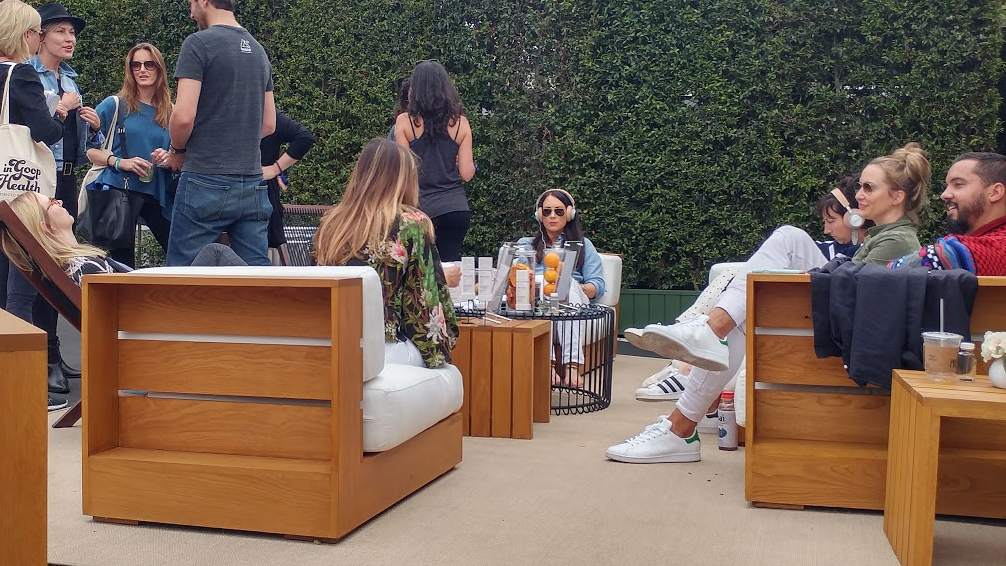
Not me, but same idea.
Since I bought a ticket, I start the morning as only one of about 600 people who knows its secret location in the trendy Culver City neighbourhood of Los Angeles. When I arrive, the parking lot of the hangar-like space has been transformed into a sort of outdoor living room, lined with greenery and furnished with white-cushioned couches. The cheerful Goop staff gives me a worry bead bracelet with a purple tassel indicating my lowly Lapis status. (Ticket levels are named after stones used in crystal healing.) I also get a tote bag in case I want to do any shopping, and a Goop-branded notebook to write down any nuggets of wisdom I might come across.
Someone hands me a smoothie, and I start browsing the “wellness activations”. The first one I find is the sound bath. If I had bought a higher level ticket, I could have experienced this in person, where sound therapy practitioner Sara Auster would play tunes calibrated to my chakras (imagined psychic energy centres in the body) using tuning forks and crystal bowls. I don’t have to totally miss out, though: There’s a station where we can listen to recordings of Auster’s handiwork through expensive headphones.
A woman in a floral dress sits on the other end of the couch, totally blissed out, eyes closed, headphones on. I ask a Goop-shirted guide to choose a track that will help me focus, and then I too close my eyes and begin to listen.
All I hear at first is some music from a loudspeaker in the distance. I listen harder. I hear the conversation next to me, a sales pitch about cannabis vape pens from a brand with no vowels in its name. (They were not available to sample.) It takes me three or four full minutes to get up the courage to ask if the sound is on. It is not.
My guide taps the iPad a few more times and cranks up the volume. Now I can get the full experience. There is a drone like a distant weed wacker, a deep throbbing hum in my left ear, and a noodling breathy flute in my right. When the session ends, I open my eyes. I don’t feel all that different, but I want to believe that the treatment worked. I want to believe that I am optimally ready to absorb all that In Goop Health has to offer.
Things I Ate
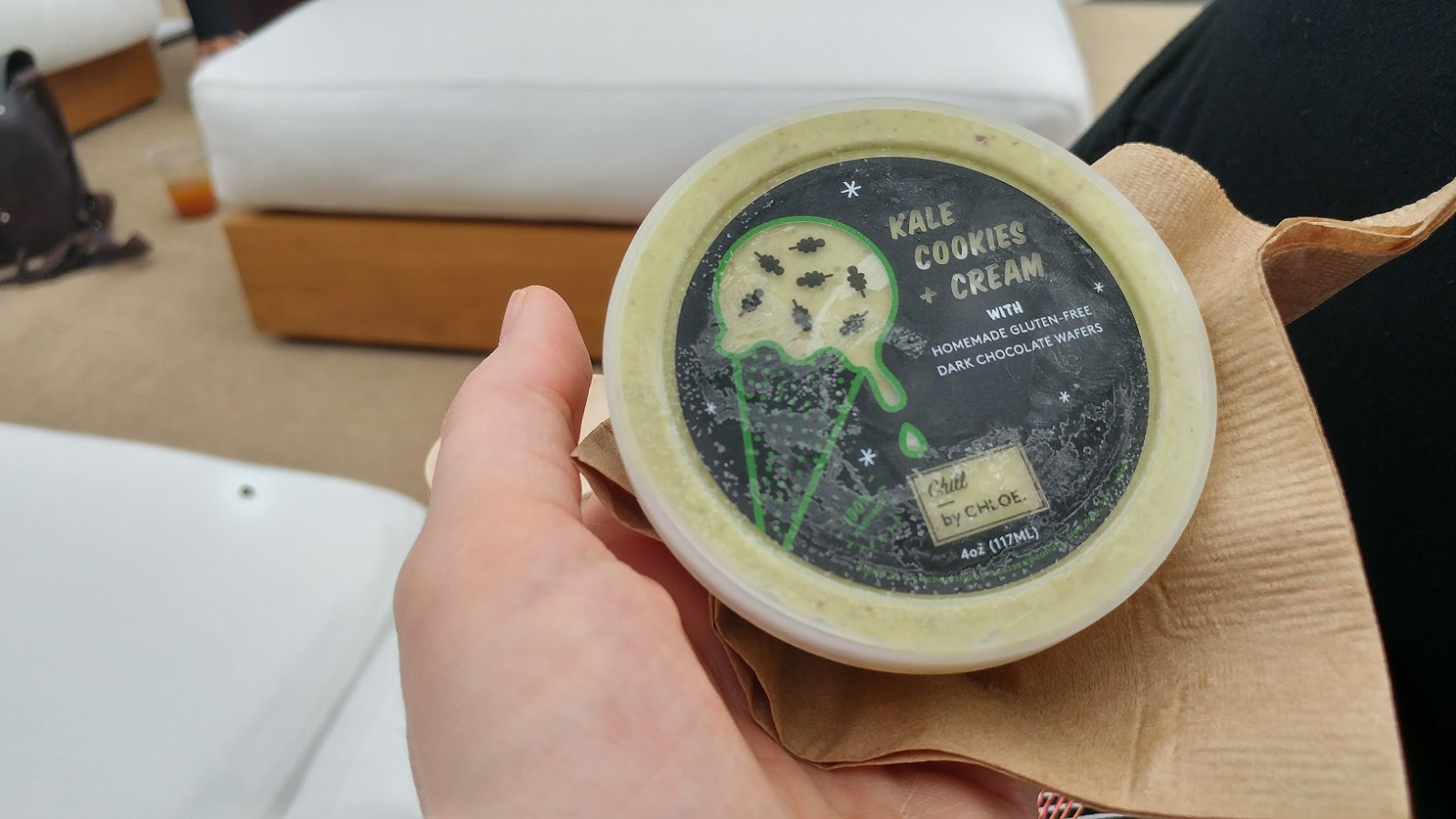
Don’t laugh. The kale ice cream was delicious.
All the food was free (or, rather, included in the price of my ticket), so I knew what I had to do. I still regret not having room in my belly for any poke or a seaweed-wrapped burrito, but I did my best to sample as many different flavours and textures as I could. Behold:
- A Tropicana pineapple mango probiotic smoothie
- A Moon Juice concoction, deep blue-green in colour, that I am told contains coconut water, spirulina and Brain Dust. It tastes kind of good but with an aftertaste of dirt.
- A tiny cinnamon sugar doughnut from Erin McKenna’s bakery, and later a strawberry one too.
- A bowl of caraway date pumpkin seed granola from Botanica, with cashew date milk.
- Bone broth from Belcampo, which tastes kind of gross, but then I add some chunky yellow liquid from a jar labelled “ginger-turmeric”, and then it is heaven.
- A banana from the table in the middle of the hall that is piled high with fruit. At this point I’m not really hungry, I just feel bad that the table looks untouched.
- A salad from Sweetgreen, their Mexican Corn Eloté Bowl with quinoa, tomatoes and goat cheese.
- A bottle of coconut flavored Baí juice, labelled Antioxidant Cocofusion. I take a sip, and then decide I am sick of sugary drinks. I don’t notice until later that there is a hidden cooler of water bottles behind the Moon Juice stand.
- Bulletproof coffee, not the homemade kind with whatever butter you have in the fridge, but the Dave Asprey approved version with Bulletproof coffee beans, grass fed butter, Brain Octane Oil, and maybe (depending on which cup I grabbed, I’m not sure) a collagen supplement too.
- A “wellness shot” that looks like a tiny bottle of orange juice but tastes like fire.
- Kale cookies and cream ice cream from Chill by Chloe. Shut up, it’s delicious.
- A matcha (green tea) latte with unsweetened almond milk and a scoop of Moon Juice’s Beauty Dust.
- I grab an apple from the table, but never get around to eating it.
- A side salad from Ancolie, with lentils and shredded carrot and I’m not sure what else. It is served in a jar, as is all of Ancolie’s food. The jar is mine to keep.
- Black coffee, from the Bulletproof coffee stand. The guy seems genuinely annoyed that I am ordering it without butter.
- A bee pollen smoothie from a company named Bumble that is impossible to google. It doesn’t seem to be Bumble & Bumble, nor the dating app Bumble, nor the verb “to bumble”, so I give up. They apparently make smoothies with bee pollen, and during one of the breaks they send out waiters with trays full of smoothies to make sure that everybody tastes these things. I am already holding a coffee, but a waiter puts a smoothie into my other hand.
Total: A bazillion kilojoules. When I was still around number five on this list, I wrote in my notebook: I am going to get so fat on health food.
Not Selfish, Self Honouring
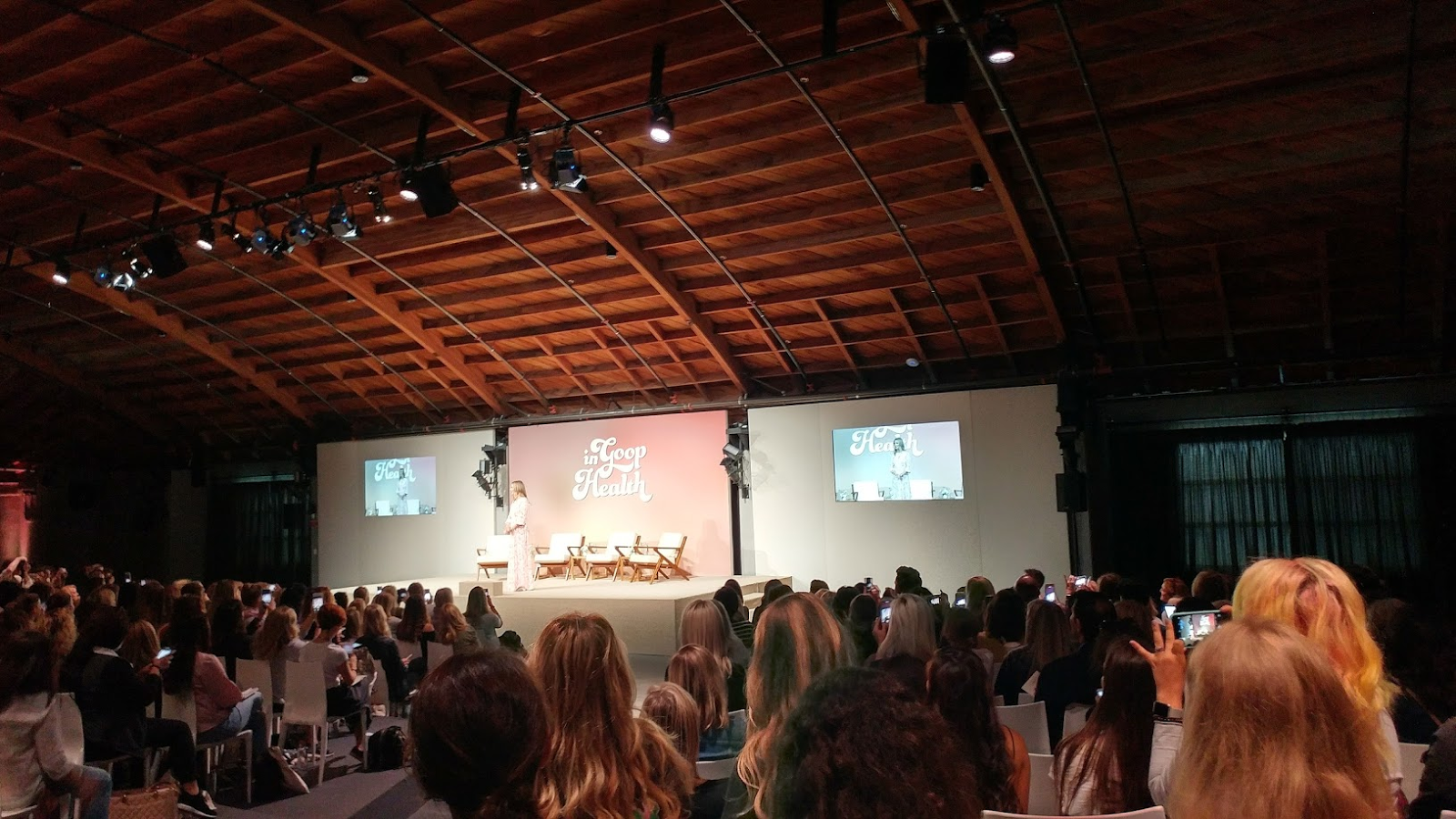
Gwyneth takes the stage. With only a Lapis level ticket, I have to sit in the back row.
I browse the hall for an hour, deciding what I would like to try (aura photography, whatever that is, but the time slots fill up while I am still in line) and what I would not (vitamins delivered straight into the bloodstream; Goop can play with my stomach, but my veins are off limits.) At 10, a recording by Gwyneth’s mother, Blythe Danner, urges us to sit down in the auditorium. She announces the location of the bathrooms “since I know you’ve all started sipping the Goop kool-aid”. And then Gwyneth herself takes the stage, wearing a floral print maxi dress that cost $US1670 ($2210), or just a smidge more than a top-level Clear Quartz ticket.
Gwyneth tells us our goal here is “achieving and being the optimal versions of ourselves”. She gives us her origin story: Her father got cancer, and so she became a health nut. Everybody who’s here today, from the doctors on stage to Sandy from Seattle who sits next to me at lunch, has a story like this. It starts with a health crisis, either theirs or that of a family member. When modern medicine couldn’t save them — or even if it did, but just felt sort of cold — they turned to naturopaths, or to “cosmic flow”, or if they are already doctors, they discarded their medical specialty and declared themselves experts in a completely different area.
Alejandro Junger, for example, was once a cardiologist but now advises people on detoxing their livers through juice diets. Stephen Gundry was a heart surgeon, like Dr Oz, but now claims expertise in nutrition and microbiology. Amy Myers specialised in emergency medicine but now writes books on natural cures for autoimmunity and thyroid conditions.
“Why is it never an endocrinologist saying your thyroid is the root of all your problems?” I had asked Britt Hermes, the ex-naturopath. In short, the legit specialists know the limitations of their specialty, and don’t promote simple cures to complex problems. She pointed me to this endocrinologist’s take on why Dr Myers misses the mark.
After Gwyneth told her story, and the audience laughed at her father saying her gluten-free zucchini bread tasted “like the New York Times”, she set up her question:
“Why do we all not feel well? Why is there so much cancer? Why do we all feel so tired?”
And the solution:
“We’ve come into this time understanding that we really do have autonomy over our health. Our psychological health, our physical health, our emotional health.”
Autonomy, I think, is the common thread of Goop’s health advice. Everything is immediately actionable. There’s always a recipe to make or a product to buy, and you don’t need a doctor’s prescription. What if we could solve our problems by wishing on a crystal? I don’t buy this idea for a second, but I’m still bummed I couldn’t snag an appointment with the crystal healer. I want to believe.
Gwyneth then introduces Dr Habib Sadeghi, her personal mentor. He congratulates us on coming here, to what is “not a convention” but a “pilgrimage”. His talk meanders, but he keeps coming back to the idea that we need to spend more time caring for ourselves. To do so, he says, is not selfish. It’s self honouring.
“Yeah, I Don’t Think There’s Any Evidence”
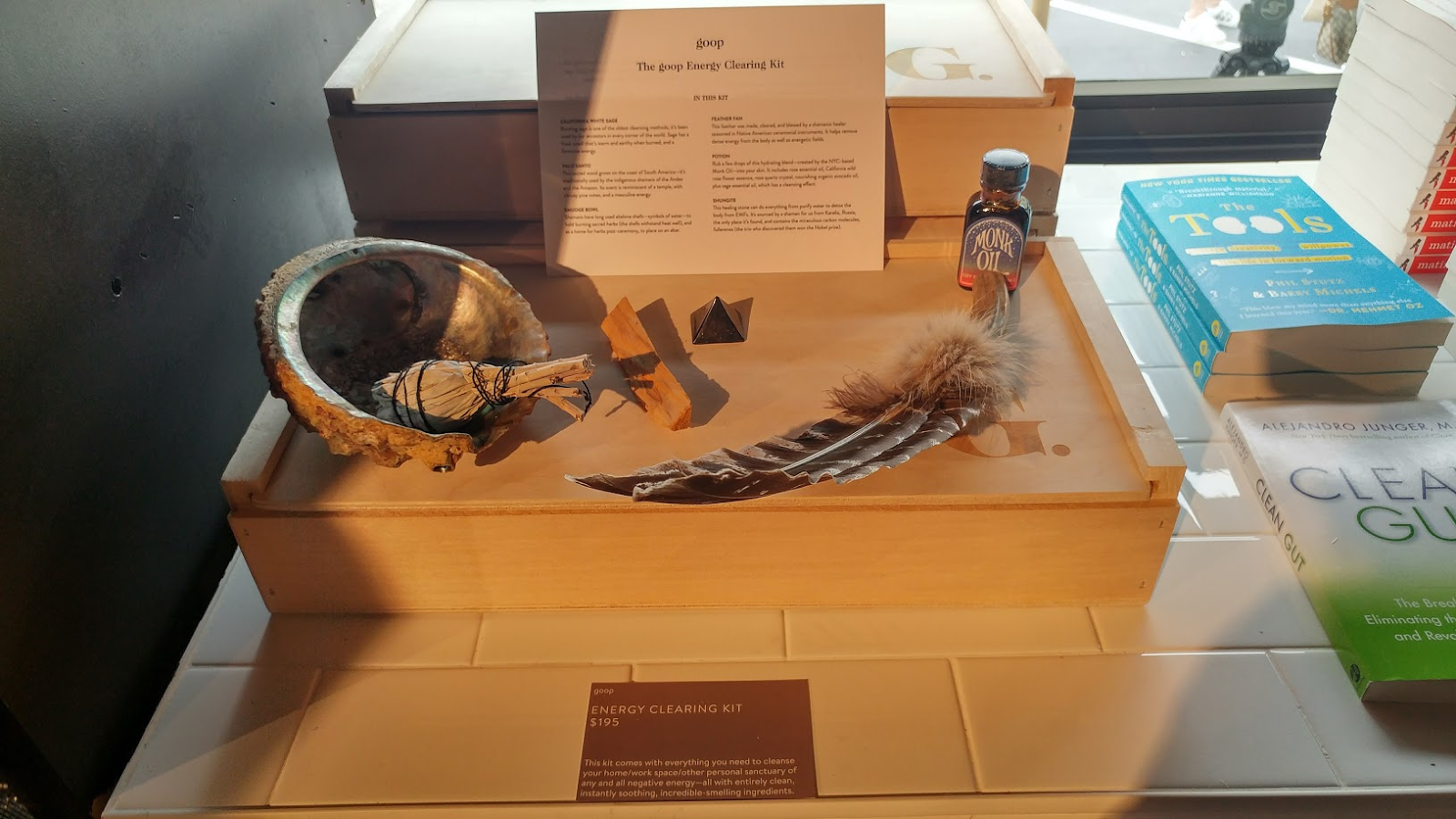
I never did ask for the evidence behind this “energy clearing kit” that comes with sage, feathers and a fancy crystal.
By mid-morning I’ve heard enough sales pitches that I realise I need to dig deeper than listening to rehearsed spiels. I decide I’m going to ask for the evidence behind anything somebody tries to sell me.
So I ask a saleswoman in the beauty department why I should buy Goop’s deodorant instead of whatever brand the grocery store sells. She tells me we need to avoid aluminium, which is “scientifically” proven to be bad for you. She can’t really articulate why, but I don’t press, because the whole aluminium scaremongering thing is simply not true. Then she tells me I should buy Goop’s sunscreen because it’s a mineral sunscreen rather than a dangerous chemical sunscreen. (Sigh.)
Goop routinely scares people about things they shouldn’t be scared about (actual headline on the website last week: Is Your Clothing Toxic?) but there is no fear-based marketing here today. The toxins are a given, the supposed scientific proof not argued earnestly but alluded to like an acquaintance we all know. I quit my awkward conversation with this saleswoman, and scoop a free fingerful of Blue Cocoon lotion, otherwise $US180 ($238) a jar.
I try again later with another salesperson, who recommends a bath product called Digital Detox. It contains salts and French clay, and after your bath you rinse off the clay and wrap yourself in a warm towel for 30 minutes. “It’s a whole detox experience,” she says.
But she doesn’t even pretend that it can cleanse our bodies from EMF waves, as the packaging claims. When I ask for evidence, she laughs. “Yeah, I don’t think there’s any evidence. It just makes your skin feel really nice. It’s a great experience.”
The Gut Check
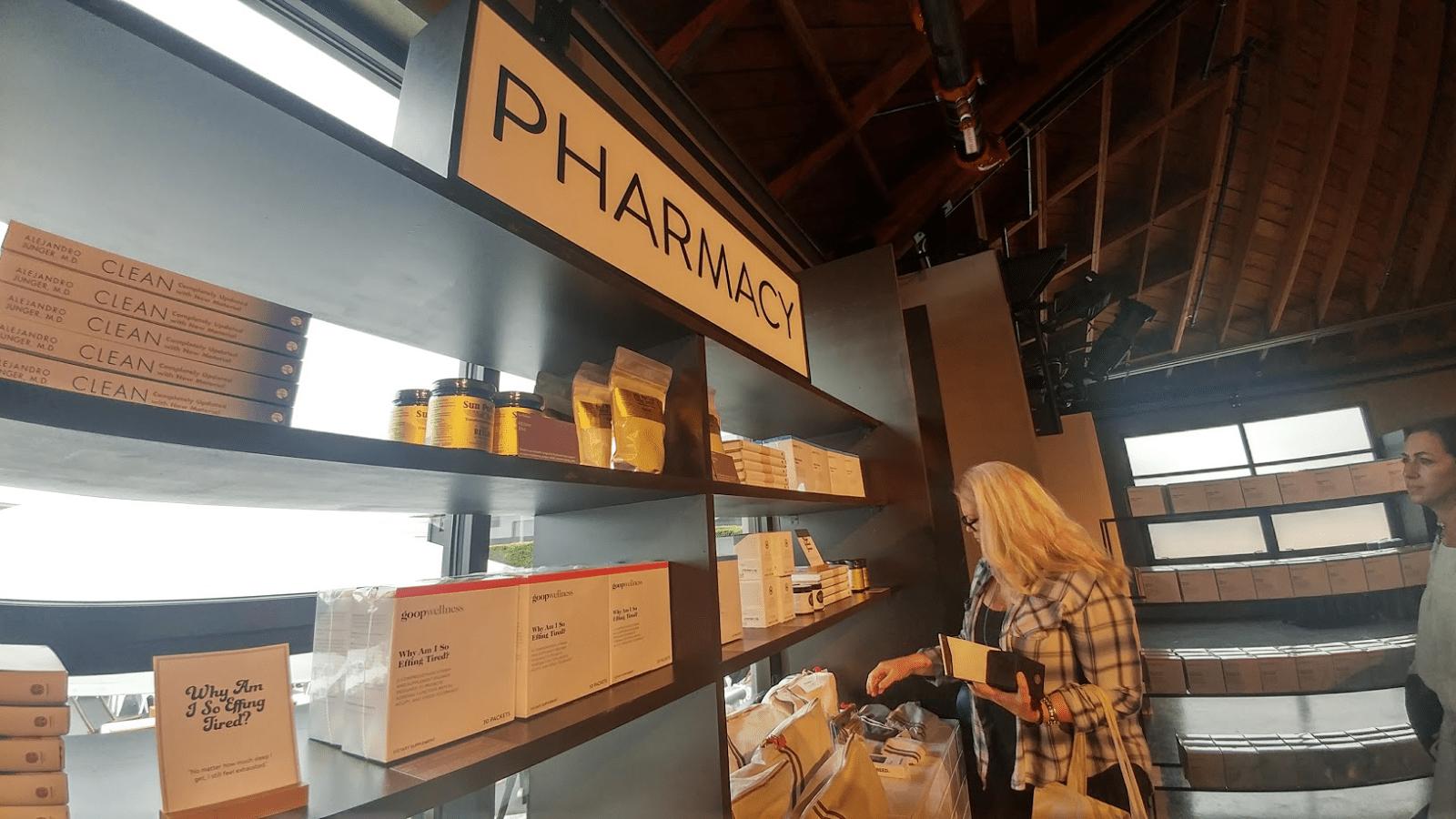
I return to the Chat Room and am devastated to realise I missed most of the panel on gut health. (I hear later that recommendations included skipping breakfast and eschewing tomatoes. Goop has not yet sent out the promised video recording of the talk.)
I could guess what I missed, though. Gut health is the cool thing to blame all our problems on these days. We really do have a ton of bacteria and other microbes in our guts (specifically our large intestine) and in other parts of our bodies, like the surface of our skin. These microbes live in complex communities, like the ecosystem in a rainforest. They certainly affect our bodies, and we affect them. This much is true.
But even the world’s top microbiome researchers can’t agree on what a healthy microbial ecosystem should like. They know that probiotics do little to nothing for us. The more we learn, the more promise we see for maybe coming up with microbe-centered treatments someday in the future, but so far all we’ve got are faecal transplants for C. difficile infections, and sometimes probiotics can help with diarrhoea.
Probiotic pills and yogurt are sold for a ton of other purposes, but the species you’ll find in probiotics are only a tiny fraction of that rich ecosystem we need. And they don’t take up residence: The probiotics enter our gut, they may (or may not) interact with the ecosystem while they’re there, and then out they go like so much poop.
[referenced url=”https://www.lifehacker.com.au/2015/04/beyond-probiotics-can-you-hack-your-microbiome/” thumb=”https://i.kinja-img.com/gawker-media/image/upload/t_ku-large/xyjlmcqrub1sf9qpue2m.png” title=”Beyond Probiotics: Can You ‘Hack’ Your Microbiome?” excerpt=”Trillions of tiny creatures call your body home, including bacteria, viruses, fungi and others. They’re not always bad news, and in fact, our health depends on having a thriving collection of microbes. Which leads to the obvious question. can we hack our health by hacking our microbiome?”]
Partners and Products
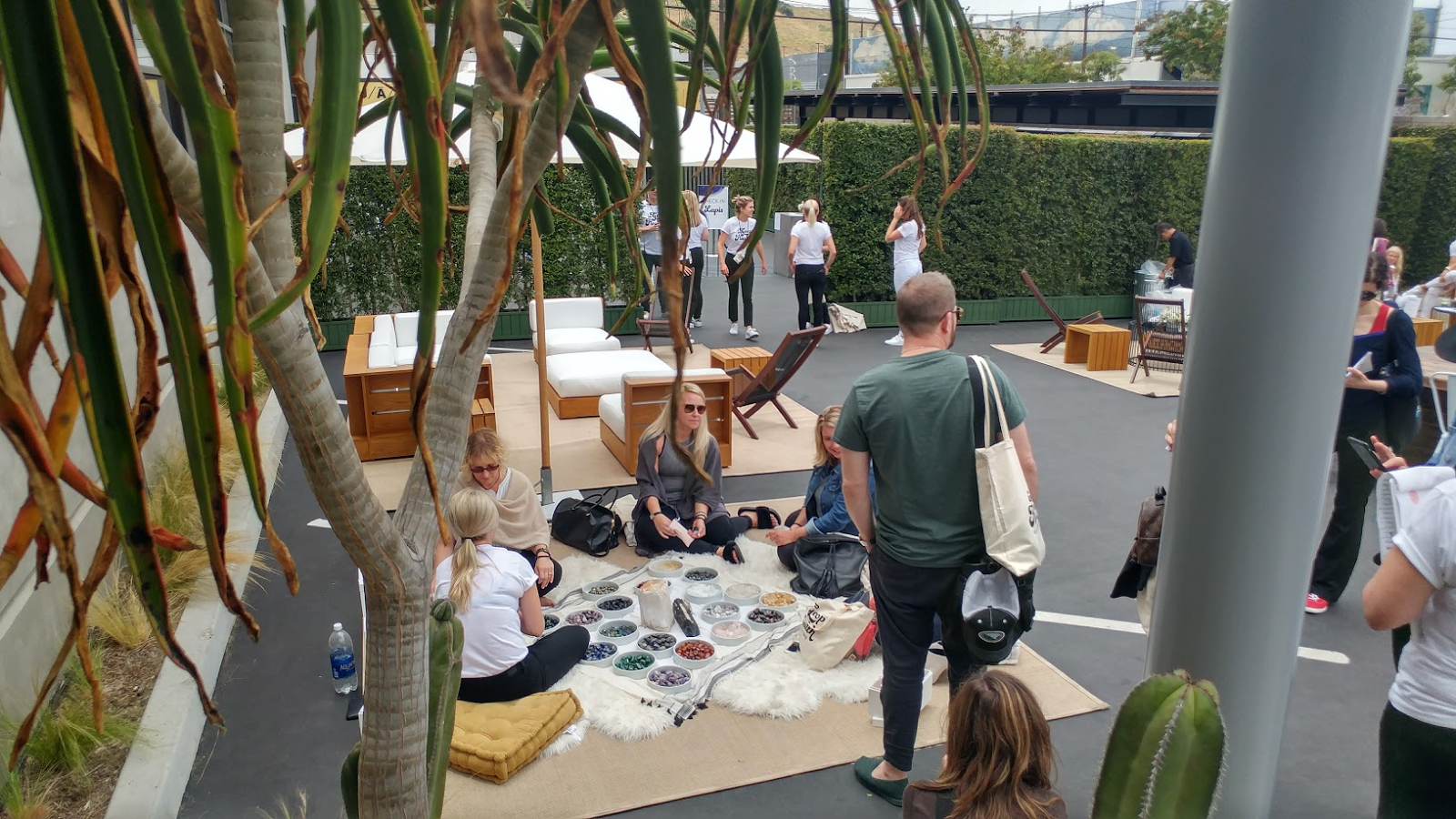
“Crystal shaman” Colleen McCann, left, at work.
Everything at Goop comes from a special partner. Dyson, maker of hair dryers, set up a mini beauty salon to show what their products can do. Luggage brand Tumi gave suitcases to the Crystal Quartz crowd, and 40 per cent off coupons to the rest of us.
Ad Week reported that brands were eager to get their names into the summit; if your target market is wealthy white women, Goop readers are golden. Elise Loehnen, head of content for Goop, said of the audience: “They’re die-hard, and they trust us, and they have the feeling of, if it’s good enough for Goop, it’s good enough for us. That’s really powerful for our partners.”
A good chunk of the Goop Hall — probably about a third — is dedicated to shopping. There is a “detox pantry” section with spices and cookbooks, and next to that a display of beauty and personal care products. A short walk away is a section of clothing, including Tory Sport workout gear, and then a “pharmacy” full of supplements and vaguely medical items. The prices are upscale: $US56 ($74) for organic lipstick, $US48 ($64) for a stylish but not very supportive sports bra, $US90 ($119) for a month’s supply of vitamins.
I figure ticket sales must have brought in a half million dollars. Goop has 585 followers on Universe, likely reflecting the number of paid tickets, and then the seating in the Chat Room clues us in to the breakdown: About 250 seats at the $US500 ($662) Lapis level, with the rest split between Amethyst ($US1000 [$1323]) and Crystal Quartz ($US1500 [$1985]). But the real value to Goop goes beyond ticket sales. Gwyneth appeared on Jimmy Kimmel in the week before the summit, after all the tickets were sold out. Tim Caulfield told me earlier that her real goal is probably just to generate discussion. “If she does that, she’ll win. No, wait. She’s done that. She won.”
In Goop Health was such a wild success before it even happened that Gwyneth and friends scheduled it as a recurring event. Expect to be “goop’d”, as the emails say, in January in New York and then again in Los Angeles next June.
Conflicts of Interest
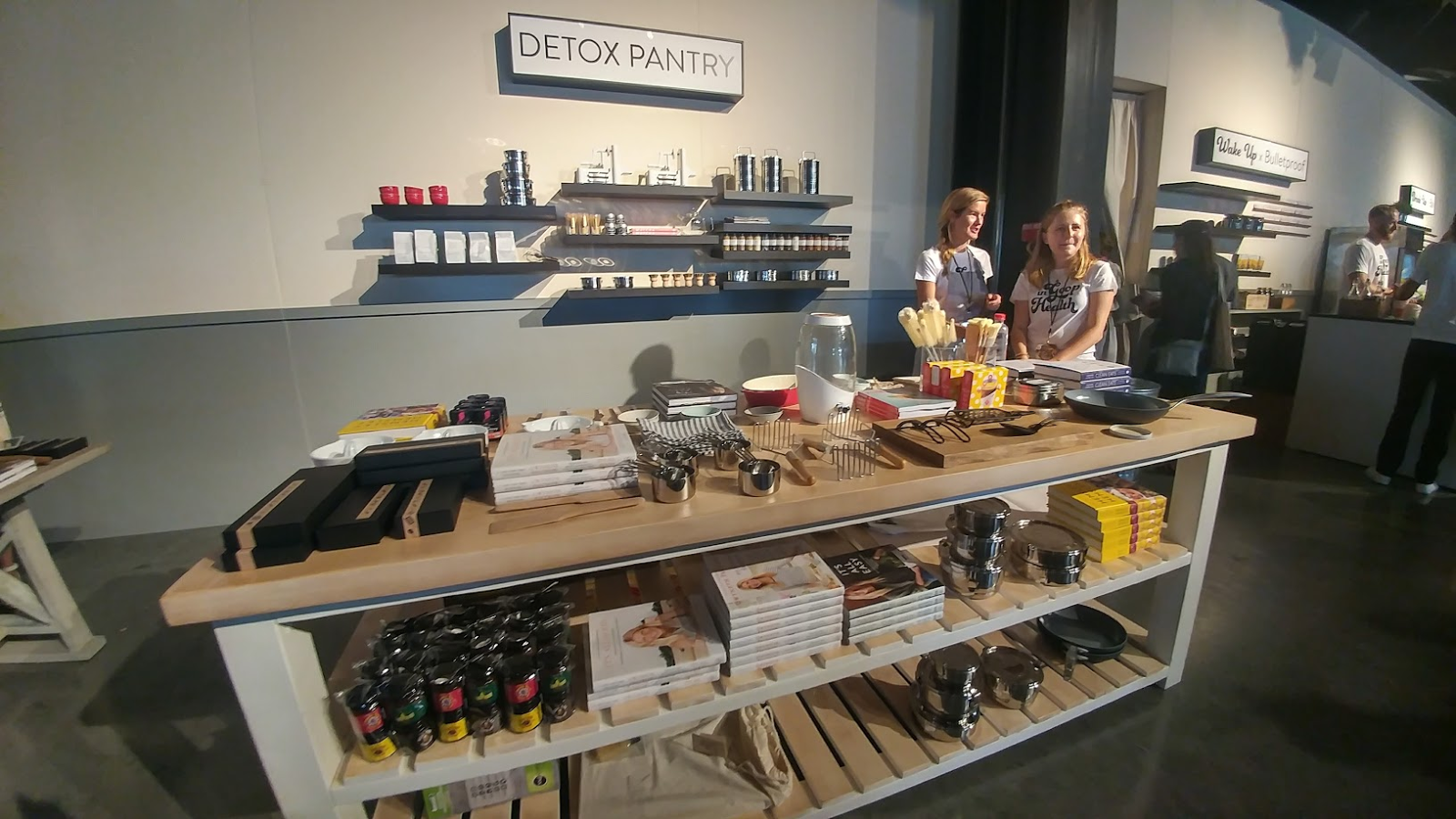
I don’t really mind that Gwyneth makes money selling clothes and cosmetics and food. But it’s a different story when her medical experts have financial conflicts of interest.
Just as doctors who own MRI machines are more likely to send patients for unnecessary scans, and doctors who receive lunches and other freebies from drug companies are more likely to prescribe those companies’ drugs, a doctor who recommends supplements and then profits when you buy them has a clear conflict of interest. Here’s what the doctors starring on today’s panels are selling (not counting books, because they all have books):
- Dr Habib Sadeghi: Says he’s not here to sell anything, but his clinic website has a shop that sells the clinic’s own brand of supplements. (Example: $US60 [$79] for an unspecified number of doses of Sekret Greener, a joint health supplement.)
- Dr Alejandro Junger: A 21-day cleanse costing $US475 ($628). You get a discount if you can rope friends into signing up.
- Dr Steven Gundry: Skincare products ($US79 [$105] to $US120 [$159]) and supplements such as the $US70 ($93) per month Vital Reds.
- Dr Amy Myers: Online courses such as this six-week one that costs $US297 ($393) and promises to “reverse autoimmunity”.
- Dr. Phil Stutz: Gives talks and workshops, but I can’t find a product line.
- Dr Oscar Serrallach: No product line on his website, but he did design Goop’s Mother Load supplement.
- Dr Robin Berman: No product line.
- Dr Sherry Sami: No product line, but she’s part of Dr Habib Sadeghi’s clinic.
These doctors’ high profile platform adds to their conflict of interest. They seem to be — and perhaps are — using their fame to drum up interest in their medical treatments and supplements. Dr Junger lists everything you could possibly ever want (more energy, weight loss, “releasing emotional blocks”) as a benefit of buying and using his products. Dr Myers goes even further, writing in her book The Thyroid Connection that “I do consider feeling less than terrific a problem — a big problem”. Who doesn’t feel less than terrific at least some of the time?
The IV Doc
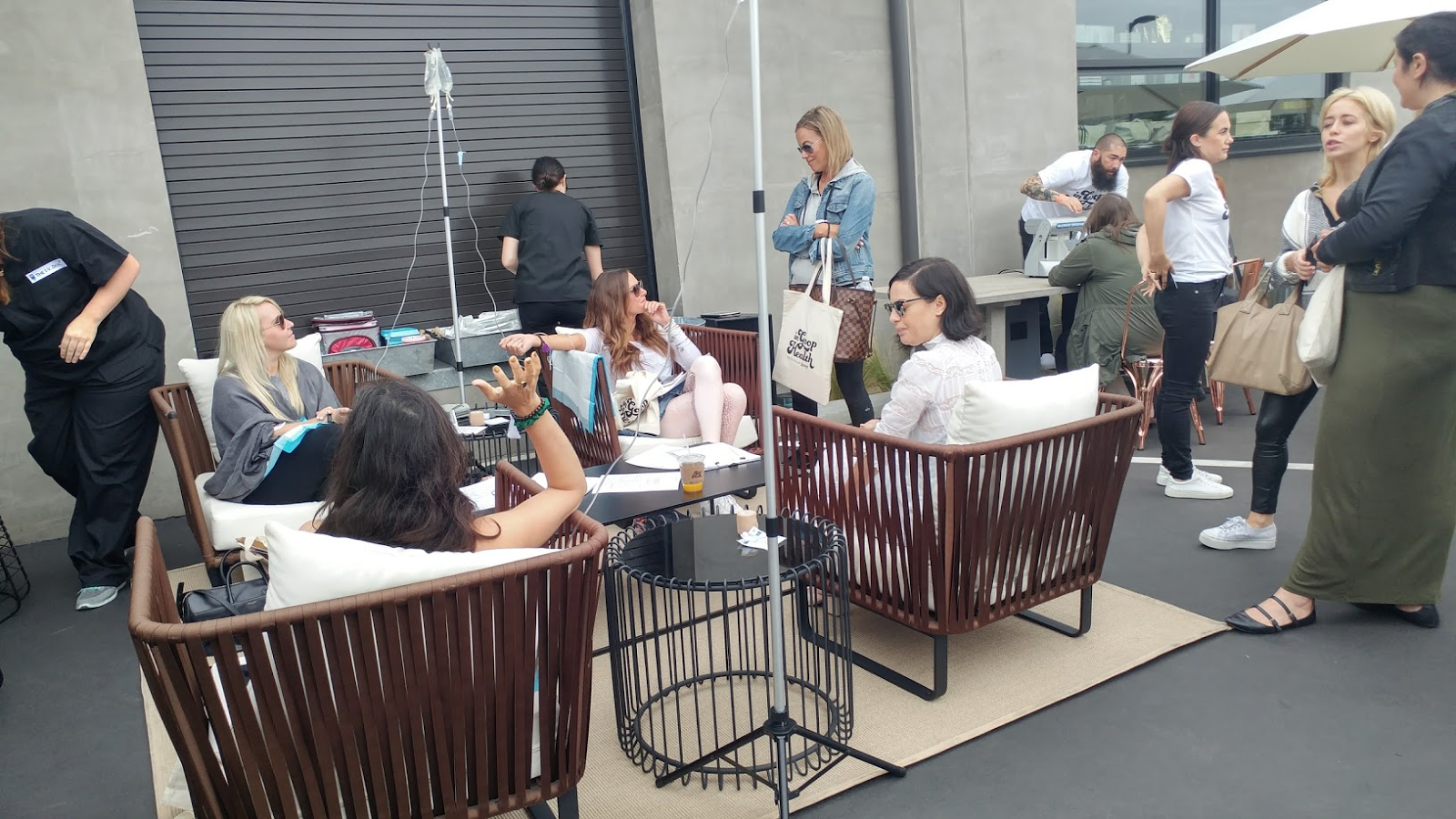
At lunch I found myself at a standing table next to a woman who had a bandage on her elbow. “You tried the IV?” I asked. “Tell me about it!”
The IVs were given by nurse practitioners with what looked like legitimate medical supplies, procedures and consent forms. They worked for a company called The IV Doc, which can come to your house or set up at your party. When the 15-minute slots for IVs filled up, they were happy to administer vitamin B12 shots to those who were waiting. A B12 shot won’t help you unless you’re B12 deficient; and if you think you’re B12 deficient, you should see a doctor, not a roving injection service that’s set up shop at a wellness summit.
My new pal said her friends had all done IVs before, so she wanted to try it too. Some love it for recovering from illness, others for hangovers. She didn’t have a particular complaint, so she just chose the one with Vitamin C and B12. When I asked how she felt, she put on a thoughtful face and sort of danced around a little bit. “I’m not sure,” she said. “I just had it done.”
The bandage on her arm was the pinkish beige shade that Crayola used to call “flesh” until somebody pointed out to them that not everybody’s flesh is that colour. It looked perfectly appropriate here, though, in an audience of nearly all white women. (There were a few women of colour, but they were outnumbered by, just for one easy example, white women wearing denim jackets.) I noticed only four men — paying customers, that is, not counting cameramen, waiters, Gwyneth-approved doctors, or the beefy dudes running the Bulletproof Coffee station. By lunchtime, somebody had printed out a unisex bathroom logo and taped it over the sign for the men’s room.
Floral Remedies
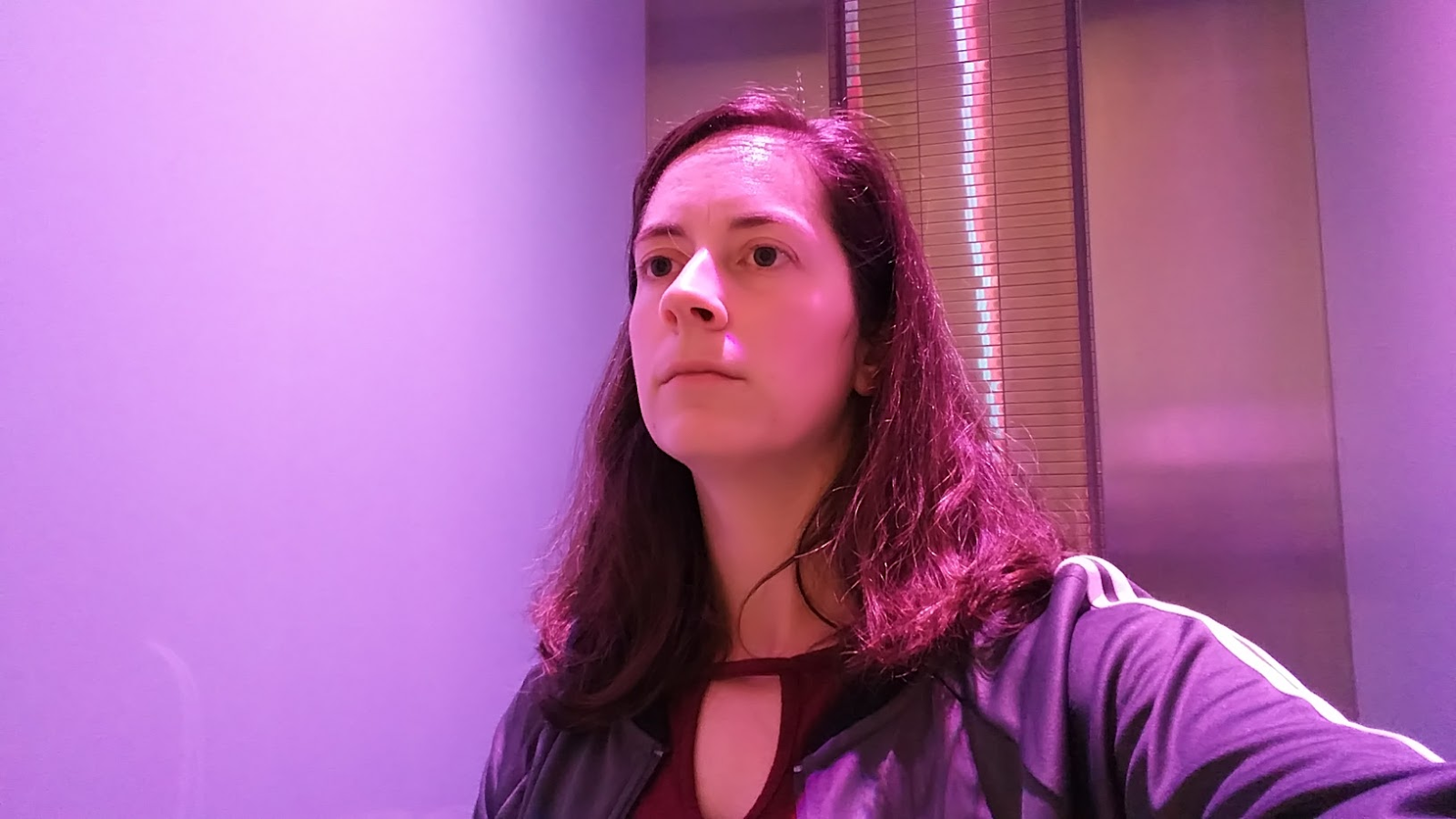
The aura photography station is still booked. After being turned away for the third time, I take a selfie in the bathroom’s weird lighting. Maybe my aura is purple?
In the afternoon, a floral remedy station appears in the hall, and I am curious to learn if there is any science behind it. I figure my chances are about 50/50.
Plenty of botanical extracts and herbs have medicinal properties, but it’s easy to get a bit too optimistic about how much they can help us. Willow bark can reduce inflammation, for example, but a synthetic version of its active component, better known as aspirin, does the job much more reliably. Echinacea is supposed to be good for colds, but so far studies have not been able to find a significant effect. Maybe it helps a little, or maybe not at all.
The botanicals that do work should be treated with caution: Yohimbe, for example, is sold as an aphrodisiac and it may in fact have Viagra-like properties. But it can also cause irregular heartbeat, dizziness and anxiety, so a yohimbe supplement is not something to snarf down just for fun. On the other end of the effectiveness spectrum are homeopathic remedies, which don’t work because they can’t: They claim to contain magical properties that operate outside the realm of physics. It turns out that flower remedies, while not exactly homeopathy, operate on a similar principle.
The concept was invented in the 1930s by a British doctor, the practitioner, Alexis Smart, tells me. The doctor identified 38 flower essences, and Smart uses a selection of these in each bottle. The flowers all grow wild in England and Wales, and they are floated in a crystal bowl of water in or near their natural habitat. After hours in the sun, the water absorbs the healing vibrations of the flower. The water is then mixed with organic brandy and bottled.
It takes three weeks for people to really see results from floral remedies, says Smart, but she’s offering doses of them today just as an introduction. Maybe we’ll feel different after we try them, maybe not. “How do you know they work?” I ask. “By talking,” she says. “I just talk to the person and can see the signs of a remedy.”
I ask for something that would help me as a writer, but Smart says, “I knew which one you needed before you even said anything.” She shows me a bottle labelled Ganesh, after the Hindu remover of obstacles. She points to the line on the box that says it’s good for “creative block”, but I notice that it’s also indicated for “lack of confidence”. It tastes like plain brandy.
I Talk to the Editors
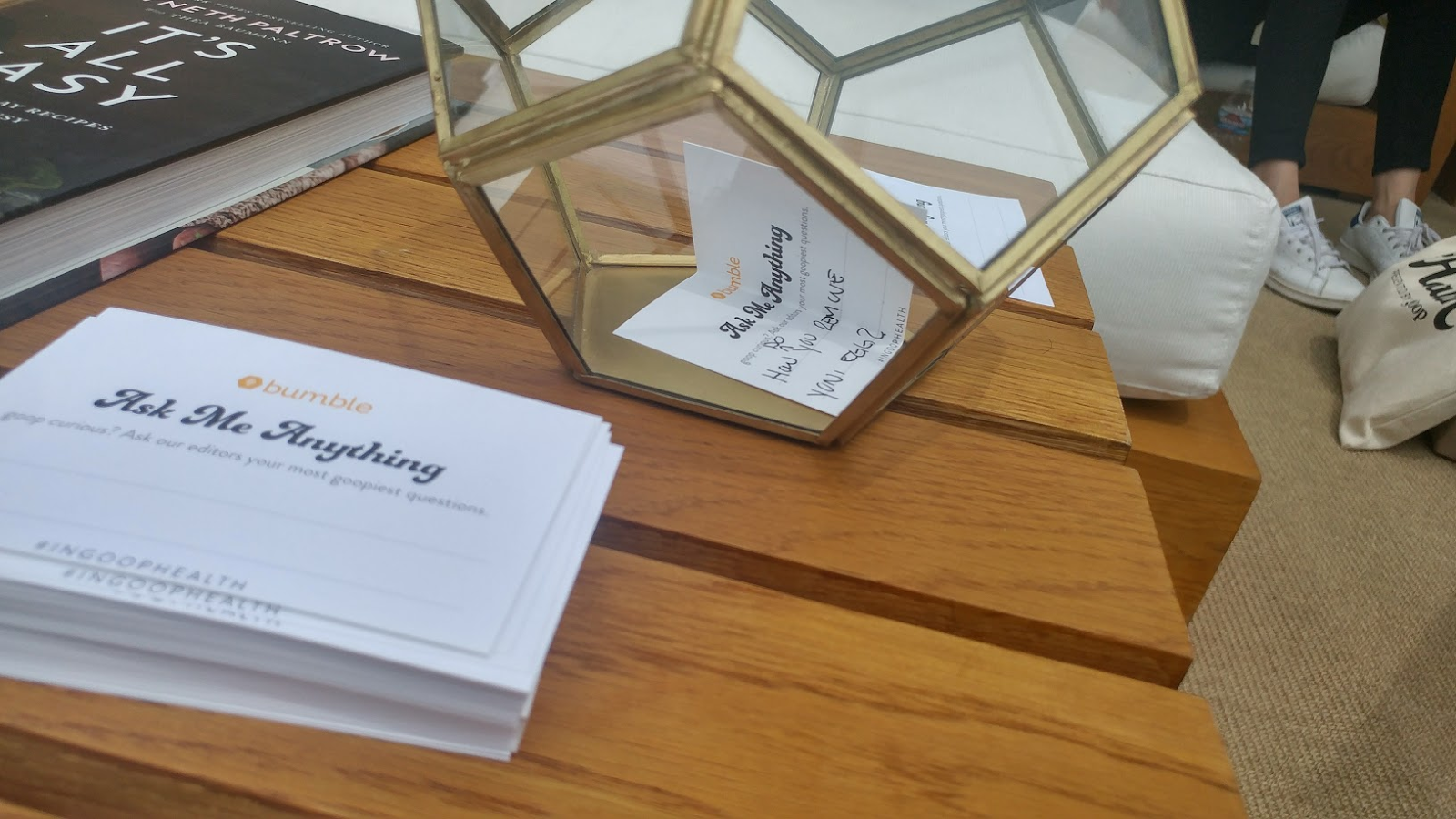
A jar of anonymous questions for Goop’s editors. The only card I see in the jar all day is this one, which reads: “How do you remove yoni egg?”
When Goop publishes something weird or, worse, harmful, I often find myself wondering what are they thinking? Recently, on Jimmy Kimmel, Gwyneth laughed at some of the newsletter’s weirder recommendations and said, “I don’t know what the fuck we talk about.” I know Goop is Gwyneth’s brainchild, but I also know a woman of her status does not write a weekly newsletter by herself.
Luckily, there is an “Ask Me Anything” stop staffed with Goop editors. They lounge on white-cushioned chairs, under umbrellas for shade, and are dressed in light blue button-down shirts. The editors are mobbed all day. Whenever I stop by to eavesdrop, it sounds like attendees are pitching them products to feature.
I find the station quiet during one of the more popular talks, and end up speaking with editorial director Nandita Khanna. “You publish a lot of things that are outside of the mainstream. What are your criteria for determining that something is safe and ethical to recommend?”
Khanna starts by pointing out that they include a disclaimer at the bottom of health articles. This is true. It reads:
The views expressed in this article intend to highlight alternative studies and induce conversation. They are the views of the author and do not necessarily represent the views of goop, and are for informational purposes only, even if and to the extent that this article features the advice of physicians and medical practitioners. This article is not, nor is it intended to be, a substitute for professional medical advice, diagnosis, or treatment, and should never be relied upon for specific medical advice.
OK, but how do you decide that something is worth including in Goop to begin with? “We definitely do our homework,” she says, and insists that the team extensively discusses and researches the things that end up in the pages of Goop. She won’t go into detail about the process, but she points out that some of their sources are doctors. Do you ever ask the doctors to vet new ideas? I ask. Yes, she says, often.
But she says they don’t have any specific guidelines. Sometimes Gwyneth will say she doesn’t think this or that story is the right one to tell, or maybe it’s not the right time to tell it.
So I ask: “What responsibility do you believe you have to your readers?” Here at Lifehacker, I recently killed a post I was excited about — a trick for stopping kids from unbuckling and escaping from their car seat — after a car seat expert nixed it. I feel like if I’m providing information people might act on, I have a responsibility to make sure that information is reasonably accurate and that people won’t hurt themselves (or their children) if they take me at my word.
Goop’s editors don’t see it that way. “Our responsibility is to ask questions, to start the conversation,” Khanna says. Even if the product or advice doesn’t work? “I think it’s up to each person to decide what works for them,” says another editor sitting nearby. Khanna agrees. “Medicine is so subjective.”
(Medicine, actually, is not subjective in this way. The point of randomised controlled trials, a key concept in medical research, is to set aside subjectivity and figure out what’s useful and what’s a waste of time. Nobody here, staff or attendees, seems even the least bit interested in separating the worthwhile stuff from the garbage.)
I turn the conversation to Goop’s infamous jade eggs. They are for sale that day in the pharmacy shop, and I got to hold one in my hand. It was smaller than I expected, not the size of a chicken egg but more like a grape tomato. Both the jade and rose quartz eggs have a hole drilled through the smaller end, and at first I imagined a Goop acolyte taking the egg out of her vagina, rinsing it off, and hanging it around her neck. I learned later that the hole is the answer to the question in the jar: You can attach dental floss to give it a removal string, like a tampon.
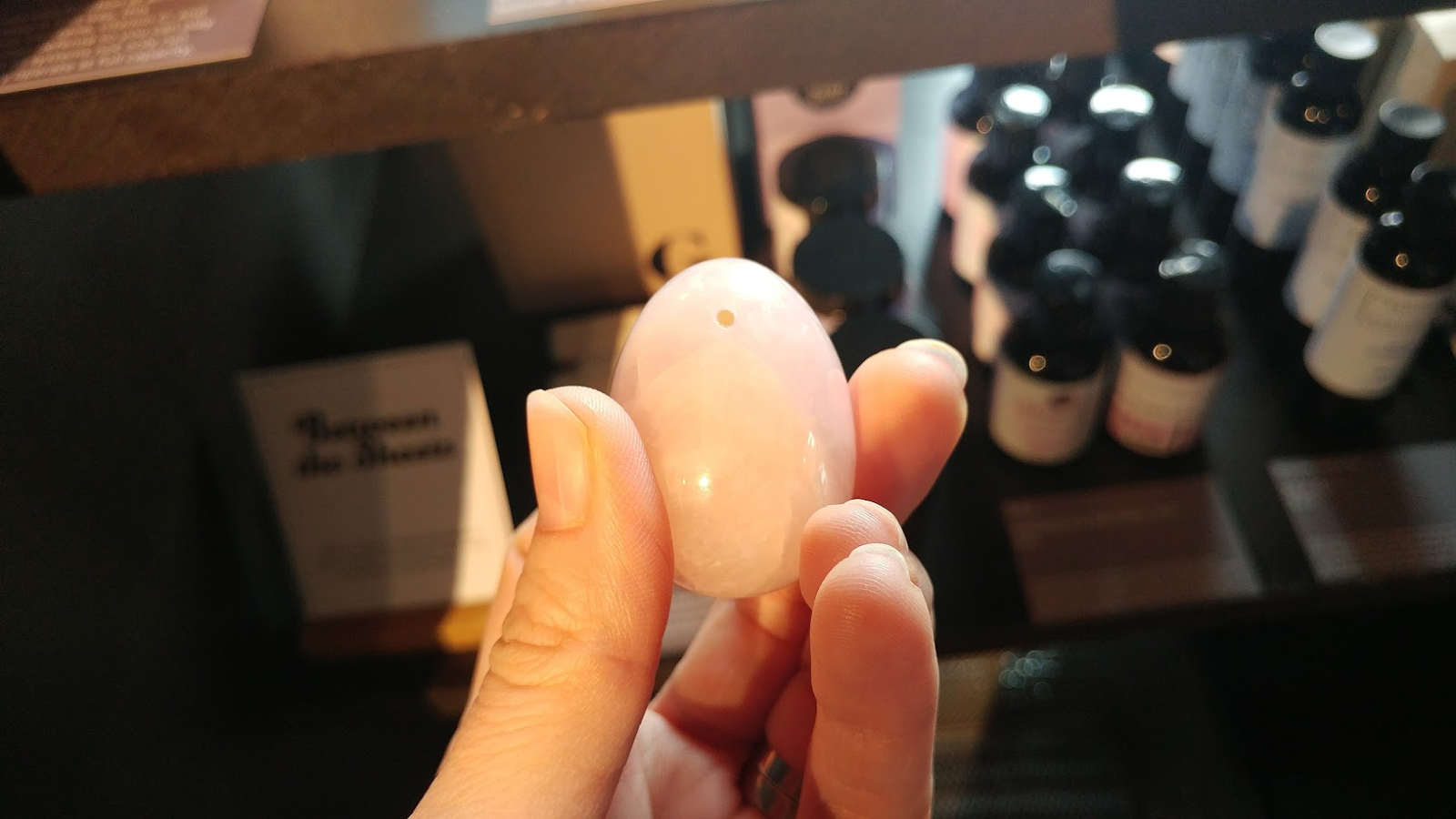
A rose quartz vaginal egg. I didn’t ask whether the floor model was for sale, but it was gone by the end of the day. If you bought this, I hope you disinfected it.
The idea of the jade egg, or its prettier rose quartz companion, is to “cultivate sexual energy, increase orgasm, balance the cycle, stimulate key reflexology around vaginal walls“. The grain of truth here is that using a small weight for vaginal exercises can help strengthen the muscles in that area. You can do this without a weight, too.
But Jen Gunter, a practicing gynecologist who is one of Gwyneth’s most vocal critics, has explained that jade eggs are a terrible idea. Stones can be porous enough to grow bacteria, and she says the instructions for using the egg are incorrect and could harm people. For example, a Goop article suggests walking around with the egg inside of you. Gunter counters that overworking your vaginal muscles this way can result in pelvic pain.
The Goop editors remember the jade egg backlash, and they are unfazed. “Did you read the letter from Layla?” Khanna asks. Layla Martin, who sells jade eggs and a seven-week course on how to use them, wrote a 2000-word “letter to the editors” defending the eggs. Goop published it in their newsletter, and underneath it, their disclaimer, and underneath that, a link to their shop.
Khanna says they “never considered backing down”. She points out, as if it were a defence, that the eggs were very popular and sold out right away. I ask her: Has there ever been a health article in Goop that you thought afterwards, maybe we shouldn’t have run that?
No, she says, never.
Aura Photography
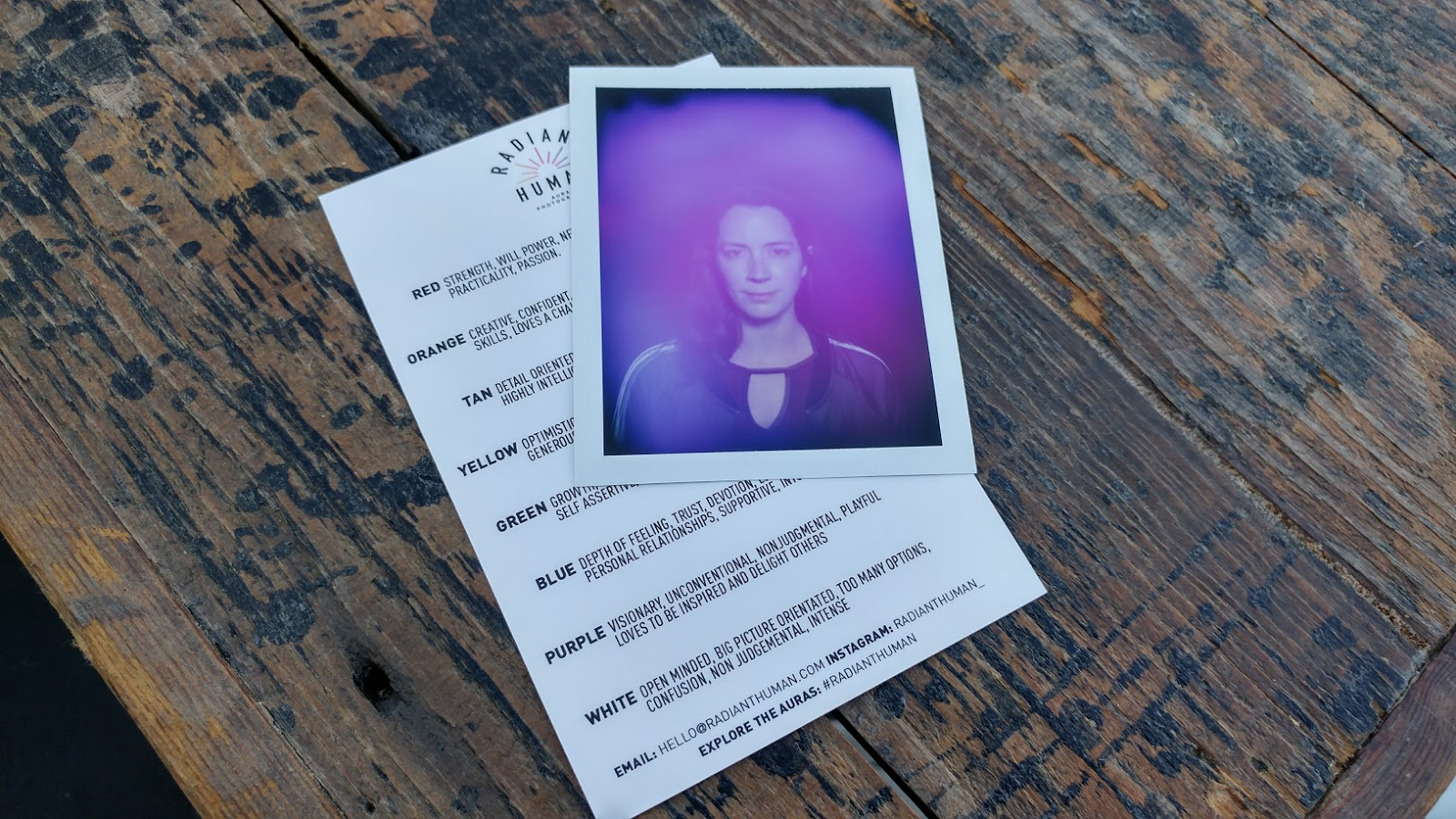
“Visionary, unconventional, nonjudgmental, playful. Loves to be inspired and delight others.”
The fifth time I stop by the aura photography station, someone is late for their appointment, and before I know it I am being ushered into the dome-shaped tent. I sit down on a stool, and the photographer puts two boxes with handprint-shaped metal contacts onto my lap. I press my hands onto them, and stare at the camera for a full 10 seconds. (“Don’t move, or the picture will be blurry.”) Then the photographer, Christina Lonsdale, sits down at a table outside with me to reveal the image.
Some people think an aura photograph can tell you what’s going on in your body and your psyche, and when aura photography first gained popularity in the 1970s, it was supposed to be a sort of diagnostic tool for figuring out which new age treatments you needed. But Lonsdale says she is not going to recommend any crystals or supplements, or tell me what I should do or think on the basis of the image. “I’m an artist. I’m not a healer,” she says. She may be the most honest person here.
Lonsdale peels off the photo’s backing, and we both gasp. Aura photos usually have multiple blobs of colour, but my image came out completely purple. This tends to mean an artist or an activist, she said: Somebody who needs to get a message out.
Briefly forgetting that auras aren’t real, I wonder if my sound bath, brain juice and Ganesh floral remedy had succeeded in enhancing my creative side. “Does this change over time?” I ask. “Like, what if I had my photo taken in the morning?” Lonsdale’s eyes widen, and she tells me excitedly: “Some people’s change, and some don’t. Isn’t that fascinating?” She’s also keeping track of what colours she sees in different cities, and from different people. Maybe when she collects enough data, she can analyse it and find patterns. But until then, she doesn’t want to speculate.
The Takeaways
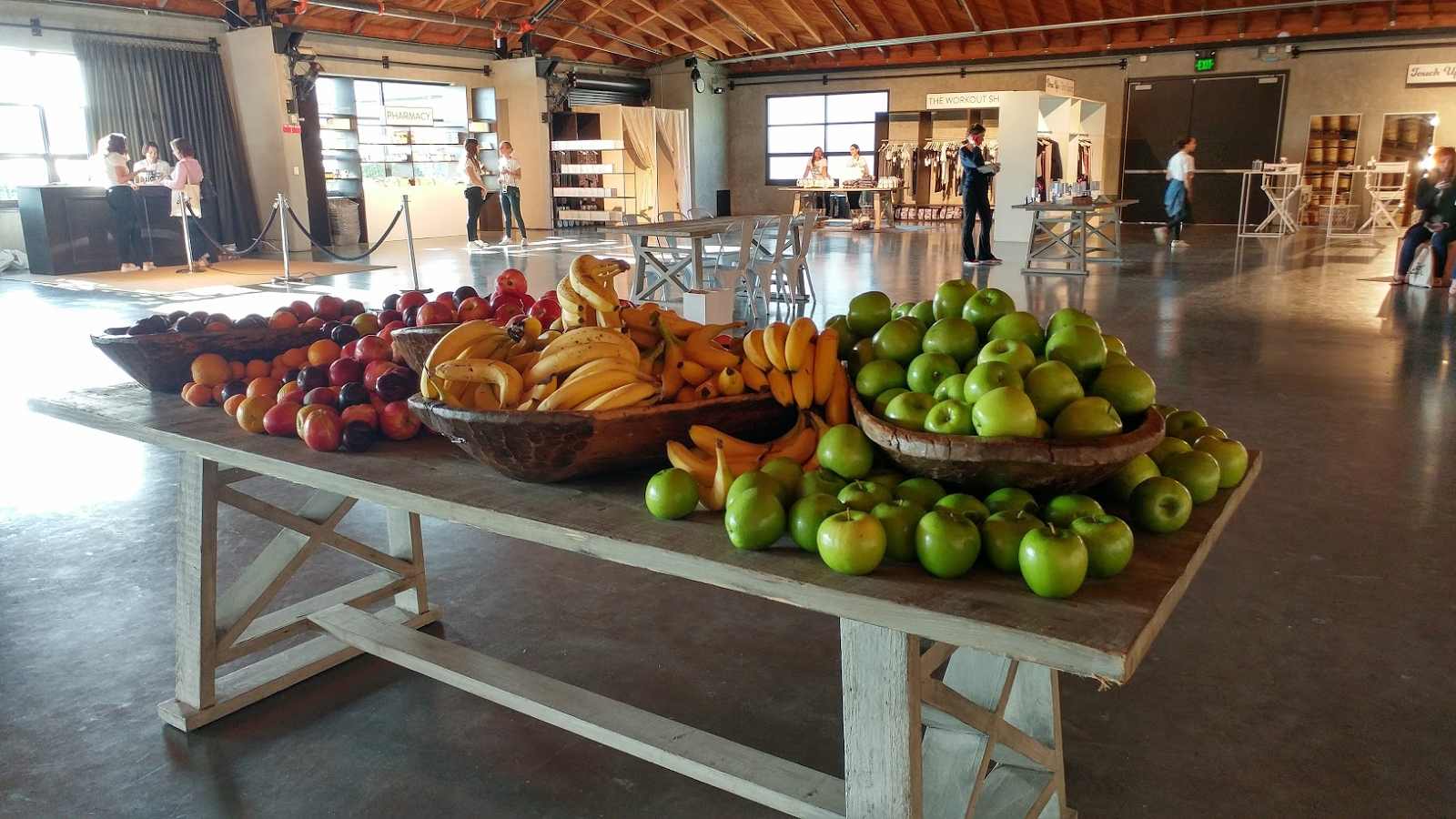
600 people have been here and cleaned the place out. Well, almost.
That’s it. Unless you have a ticket for cocktails with Gwyneth — I do not — the summit is over. I’d been at In Goop Health from nine in the morning until almost 7PM. On my way out, I pick up my “$200 [$AU265] value” goodie bag, which I figured wouldn’t hold much: Two jars of fancy lotion, perhaps. But the folks at Goop have found a way to pack an arm-breaker of a tote bag (thanks, 565g canister of collagen protein), so I get to lug the whole thing all the way back to Pittsburgh.
My tote bag may be brimming with takeaways, but my notebook is not. I didn’t pick up a single actionable, evidence-based health tip. As much as I love to play the gleeful debunker, coming up empty-handed just makes me sad. I want autonomy over my health just as much as any hardcore Goop reader.
The problem, though, is that Goop sells a fantasy of control at the same time it takes away the tools that let you make informed decisions. If you can’t tell what’s real and what’s garbage, how can you choose what’s right for you? In a world where everybody’s marketing copy is potentially true, the only way to make sense of things is to try them all.
But trying useless things costs money, and time, and mental energy. Wealthy Goop fans can afford the first of these, but it’s hardly self-honouring to give every implausible product a chance. Maybe you need to get more sleep if you’re “so effing tired”, rather than expecting a vitamin pack to do things that vitamins can’t really do.
[referenced url=”https://www.lifehacker.com.au/2016/05/the-placebo-effect-is-no-reason-to-buy-junk/” thumb=”https://i.kinja-img.com/gawker-media/image/upload/t_ku-large/a2u6c0dfudlethzmruse.jpg” title=”The Placebo Effect Is No Excuse To Buy Junk” excerpt=”We all swear by something that we know probably doesn’t work. Maybe it’s vitamin C when everyone at work has a cold, or #bootea while we diet, or compression socks while we run. ‘Even if it doesn’t work, what’s the harm?’ we tell ourselves. The truth is, it’s not harmless, and we’re only fooling ourselves.”]
But getting sleep and eating vegetables and washing your hands are boring. Why grab a piece of fruit off the table in the middle of Goop Hall when you could try a bee pollen smoothie instead? Why go for a run or lift a few weights when there’s a foam roller routine that promises to make you “taller, slimmer, younger”?
And so Gwyneth’s open minded attitude goes to waste. Instead of trying new things and reporting back about which ones are worthwhile, the Goop machine just adds more products and ideas to the already confusing array of options we face. And if anybody criticises that approach — like me, perhaps — Goop’s fans aren’t deterred. Parenting panelist Robin Berman praised Gwyneth’s bravery in this realm: “Anytime you stick something new out there, you’re a warrior. You’re going to get grief for it.”
Epilogue: The Goodie Bag
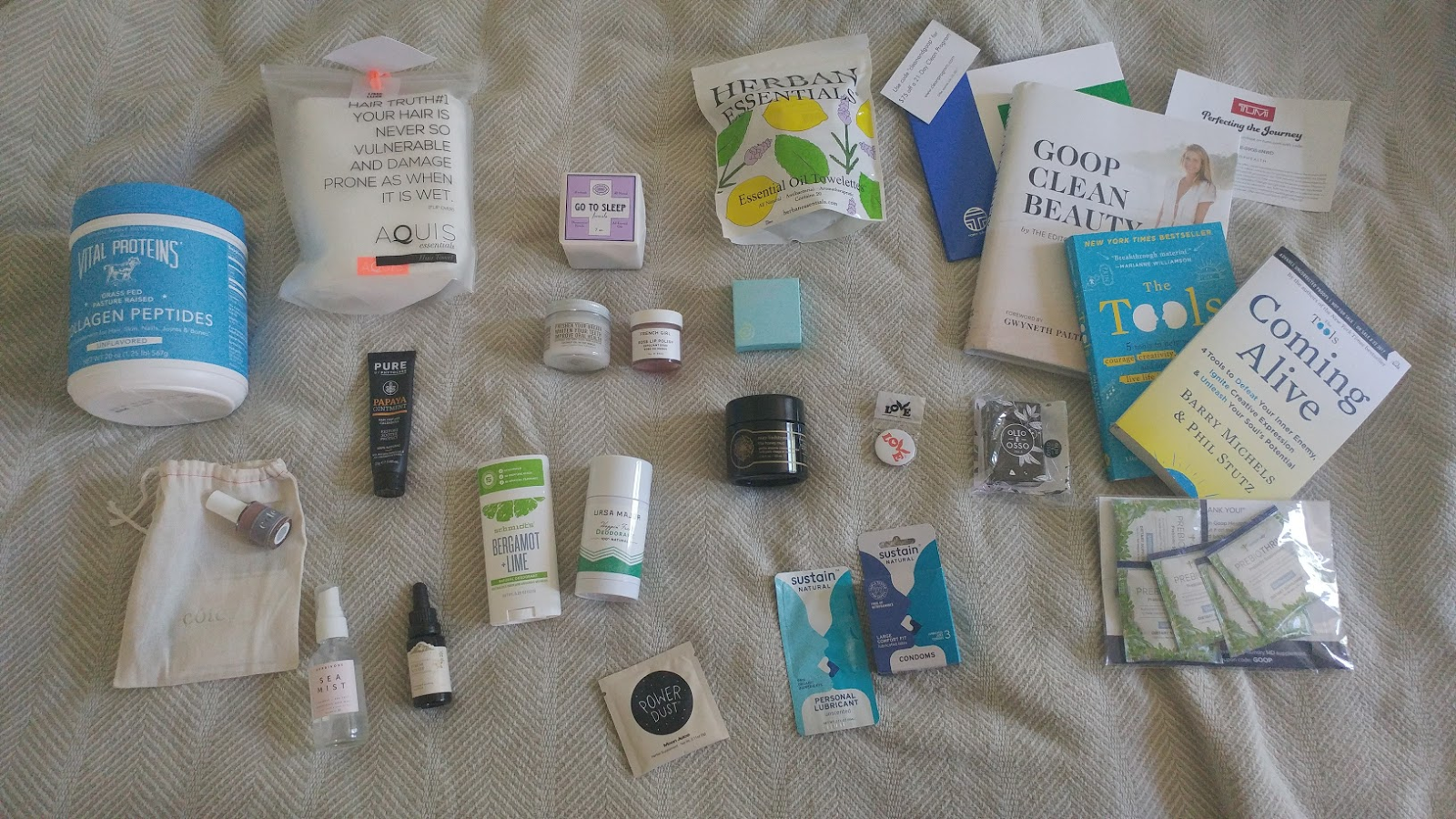
The haul. From left: Collagen protein powder (blue can), Côte nail polish, Aquis hair towel, Pure phytocare papaya ointment, Herbivore sea mist spray for hair, Floracopeia stress relief floral remedy, Schmidt’s bergamot lime deodorant, Ursa Major deodorant, Moon Juice Power Dust, Jane Inc “Go to sleep” bath bomb, Skinny & co coconut oil, French Girl rose lip polish, Herban Essentials essential oil wipes, Cocofloss, May Lindstrom honey mud, Sustain Naturals condoms and lube, Olio e Osso lip balm, Dr Gundry’s prebiotic supplements. Books: Goop Clean Beauty, The Tools, Coming Alive (the yet-to-be-published sequel to The Tools). Coupons for: Tory Burch Sport, Tumi luggage, Dr Junger’s 21-day cleanse, Côte beauty products. Not pictured: Babo botanicals children’s hair conditioner, two Tracy Anderson cherry pie flavoured protein bars, and an mp3 player pre-loaded with Headstrong meditation tracks.
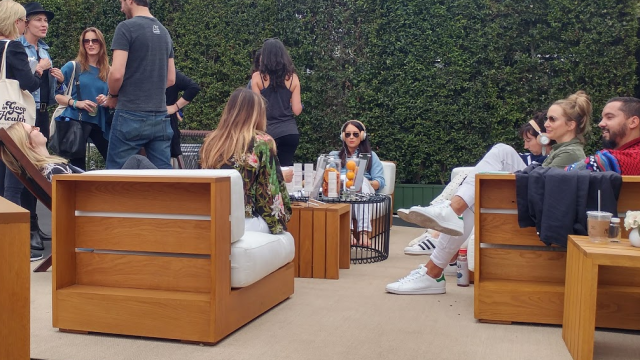
Comments